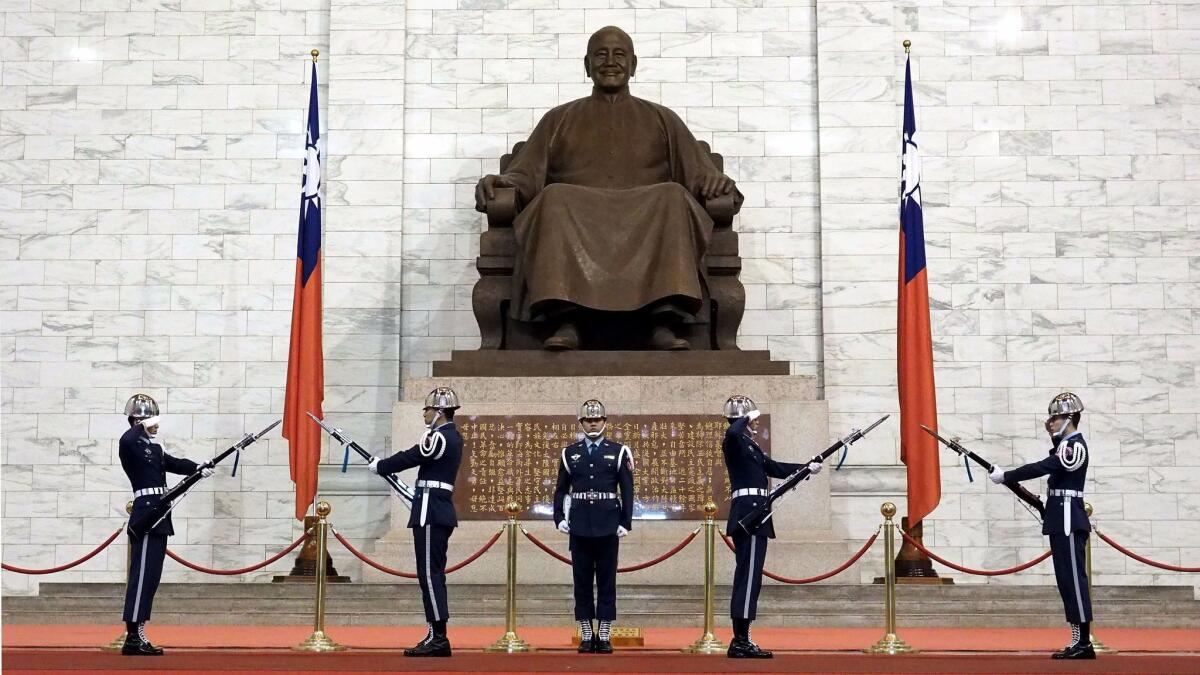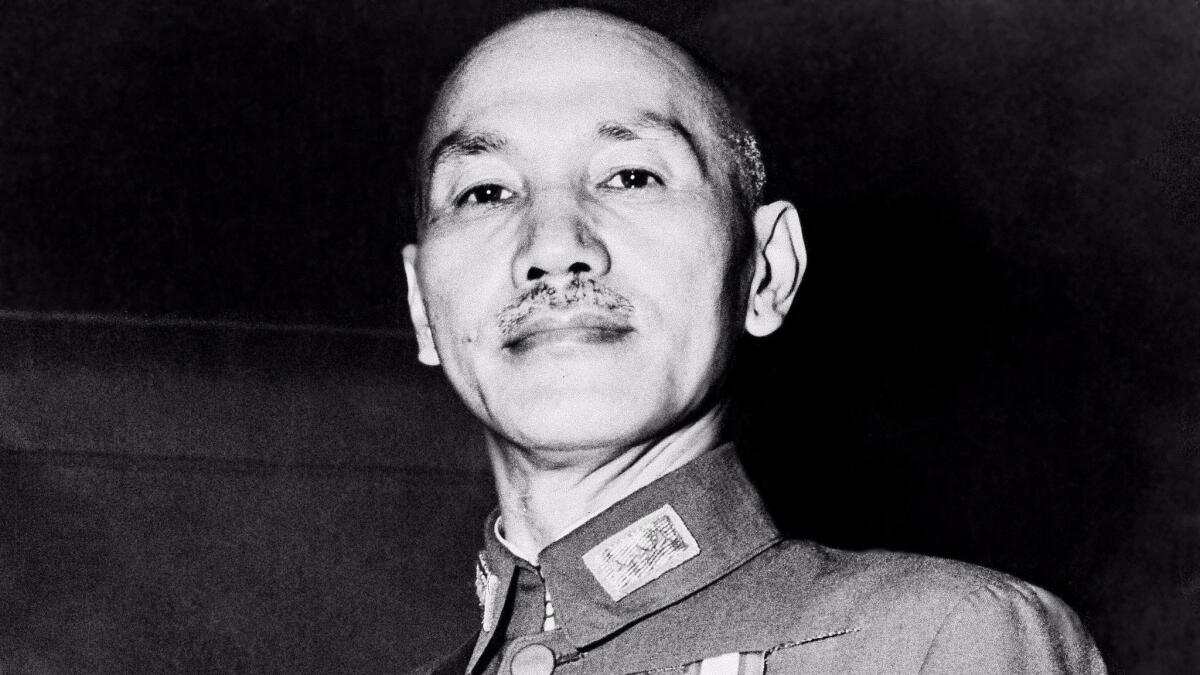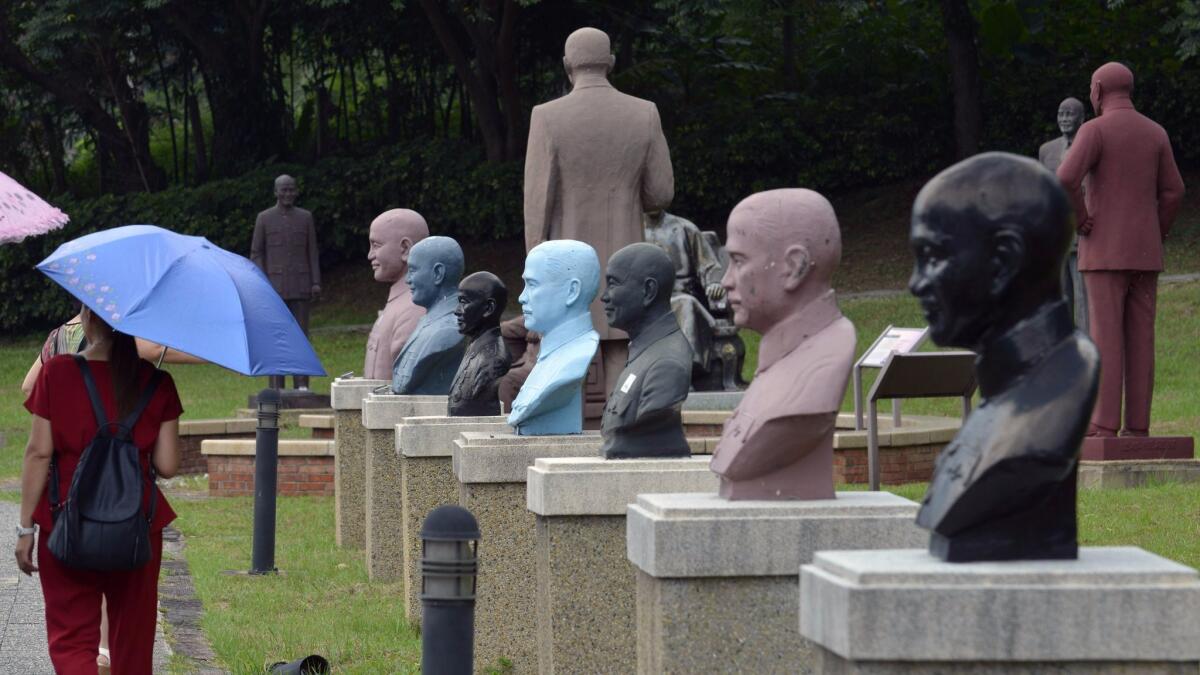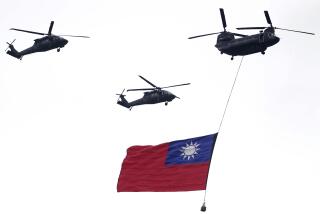Taiwan has statues of him everywhere. Now many want Chiang Kai-shek’s image removed

- Share via
Reporting from TAIPEI, Taiwan — Across Taiwan, his image and name are everywhere — on statues and street signs and at a lavish memorial hall in the capital. Chiang Kai-shek was long heralded as a national hero who worked to unify China and fought both the Japanese and the communists.
But now many Taiwanese view Chiang as a despot who repressed island culture and unleashed a deadly campaign against dissent. This week, Taiwan’s parliament passed a bill calling for a full investigation into the authoritarian rule of the late strongman while erasing his name and likeness from landmarks across the island.
The parliament dominated by a party that opposes Chiang’s Nationalists approved a “transitional justice” bill late Tuesday to review what became known as the “White Terror,” a period that elders still remember in horror.
“In the normal course of things, we haven’t done enough for justice,” said Yang Chen-lung, 65, executive director of the Memorial Foundation of 228, a nonprofit for victims of the crackdown. “That’s because there was no law that lets us pursue this, so it’s something we’ve looked forward to. Clearly Chiang was the mastermind behind White Terror,” he said.
The foundation takes its name from Feb. 28, 1947, when protesters took to the streets of Taipei a day after government agents beat a woman who was selling unlicensed cigarettes and shot and killed a passerby.
As many as 28,000 people were believed killed after Chiang ordered a massacre of participants in protests against his rule in 1947.
Others suspected of questioning his rule were killed or sent to prison in the decades that followed, the period known as the White Terror. Some studies say 140,000 people were imprisoned and thousands were executed. Chiang died in 1975 and Taiwan embraced democracy in the late 1980s.
Chiang’s Nationalists had fled to Taiwan in the 1940s after losing the Chinese civil war to Mao Tse-tung’s Communists.
The bill to investigate Chiang’s rule was proposed this year because the Nationalist Party’s chief opposition, the Democratic Progressive Party, controls the presidency as well as parliament. The Nationalists had controlled one or both until May 2016.
President Tsai Ing-wen backs the legislation and is expected to sign it by year’s end.
In February she called for opening classified documents from Chiang’s rule and within three years completing a report on suppression of protests that began Feb. 28, 1947.

The bill would allow that investigation to proceed, said Liu Chao-hao, a ruling party lawmaker who worked on the legislation.
People harmed during the White Terror expect the bill’s outcome to give them a sense of justice, Liu said. “This is totally positive, 100%,” he said.
Many Taiwanese welcome the chance to assess Chiang’s rule.
“I believe the majority [of Taiwanese] prefer to fairly and reasonably and apolitically review what Chiang did, not to hunt down his past in a parochial and political way,” said Huang Kwei-bo, vice dean of the College of International Affairs at National Chengchi University in Taipei.
The legislation will require government offices and schools to remove statues of Chiang. Schools as well as streets bearing his name across the island of 23 million people should eliminate those references, according to the bill’s text.
Under then-President Chen Shui-bian, who was modern Taiwan’s first non-Nationalist leader, the government encouraged schools and other institutions to remove the balding, smiling effigies of Chiang from their campuses. About 200 statues were removed and ended up in a park in Taoyuan, where they are a tourist attraction.

An untabulated number of other institutions retain their statues, while roads in most cities bear Chiang’s nickname “Zhong Zheng.” The name is ubiquitous, as common as “Broadway” or “Main Street” in the U.S.
The bill passed in line item form, making it hard to calculate a vote percentage, but ruling party lawmakers say most of their members favored it.
Chiang’s legacy is complicated, to say the least. Over the decades the U.S. viewed him as an ally, but also with suspicion.
Chiang succeeded Sun Yat-sen as the leader of the Nationalist Party, known as the Kuomintang, which helped overthrow China’s last imperial dynasty and establish the Republic of China. When the Nationalists fled to Taiwan, they repressed local languages and customs.
In recent years, Taiwan removed his name from Taipei’s international airport and his likeness from currency.
Jennings is a special correspondent.
More to Read
Sign up for Essential California
The most important California stories and recommendations in your inbox every morning.
You may occasionally receive promotional content from the Los Angeles Times.










